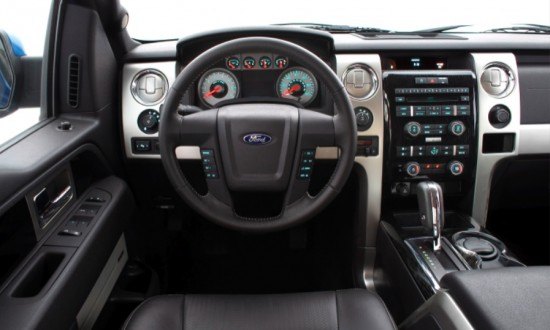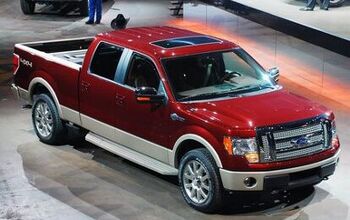Review: 2009 Ford F-150
Although the U.S. pickup truck market is suddenly a lot smaller, it’s not small. And while Ford is scrambling to make something, anything profitable in the car segment, the F-150 is still a large part of the reason why the company remains out of bankruptcy court. In fact, in September, the Ford F-150 outsold all Ford cars combined. That’s a lot of pressure for a truck to carry on its frame, even with over 3000 lbs of payload capacity. And so, the 2009 F-150 is here, hoping to prove the value of the old British adage, if you’re in a hole, the first thing you do is stop digging. Or at least shore-up the floor so you don’t sink into an abyss. Does the new F-150 have what it takes to at least keep Ford in the game?
Not if you buy your pickup according to horsepower ratings. Or torque. But, thankfully for Ford, in a strange sort of way, the power-obsessed vanity truck buyer has left the building site. Because the new F-150 leads the pack in functionality. It’s not just the F-150 capabilities, but how nonchalantly the F-150 performs them. In this, the new F-150’s leagues ahead of the Dodge Ram, Chevy Silverado, and Toyota Tundra.
The F-150’s bed is a perfect case in point. While it’s still too high (as in all “full-size” trucks are too big), the bed has available kick down steps on both sides. It’s not a high tech solution, but when it comes to a work truck, that’s a good thing, not a bad thing. IN keeping with its “tough luck” I mean “truck” meme, Ford over-engineered the steps to take 500 lbs of weight. As a hand-me-down from the nearly obsolete F250 Super Duty, the tailgate has a fold down rear-step and vertical hand grip. Good thinking.
Another example: the factory-installed cargo rails in the sides of the bed are again laughably well over-engineered, with 600 lbs of capacity each. They’re also a breeze to configure. Once in place, you can snap-in all manner of accessories to divide the cargo area.
I towed 7000 lbs. trailers back-to-back in the Ford F-150 and top of the line Toyota Tundra, Dodge Ram and Chevy Silverado. For the most part, it was a beating. The F-150 has an integrated trailer brake controller and Trailer Sway Control– which the computer somehow manages to coordinate with Roll Stability Control and the other alphabet soup equipment. I tow six times a year and unlike the editor of Trailer Boat magazine, who was feeling the temperature of the trailer wheels after driving, I’m not even close to an expert. But that’s the key.
I’m a towing layman. And between comparably equipped trucks, the Ford was infinitely easier to drive than the Dodge and Tundra, both of which had transmission hangups that made towing a chore and engine braking nearly impossible. The Silverado 6.0 performed very well, if not as coolly as the F150, the outcome of overactive brakes and a jumpy transmission.
The F-150’s easy/breezy/beautiful [cover girl] nature also comes through in on road driving, handling and hauling. It has actual steering feedback– where its competitors’ tiller feel is either as wooden as Pinocchio’s half-brother (Silverado) or as nonexistent as a TTAC review without a simile (Tundra). Again, the genius here is that a non-truck person would feel comfortable driving it.
The interior doesn’t get the same rave review. The good news is that the new seats are exceptionally comfortable. Now the bad news about the interior: everything else. While all the features are there (including Microsoft Sync), liberally applied silver colored plastic on the dash looks and feels cheap. The plastic on top of the dash is craptastic, too. And the unnecessary chrome surrounding the gauges on several trim levels is gaudy and imperfect. That said, the cheaper trim level trucks, like the crank-window XL and slightly better equipped STX, are clad in a sea of charcoal grey plastic that looks the part of “truck you’re going to beat the stuffing out of.”
Ford’s gambling (not gambolling) that the remaining truck buyers in the next few years will buy because they want some practical. That’s why Ford focused on cargo bed, towing, steering, and seats rather than maxing-out the performance. Either that or it is a very happy coincidence indeed. Whether or not this kindler, gentler but steadfast and true truck approach will actually pay off is hard to say. They might score some “image” buyers because the F-150 has the image of a work truck– because it actually is one.
Ford says they’ve seen people trading down from Super Dutys to the F-150 because it’s so capable. I’ll buy that for a dollar. But what about everybody else, for whom the F-150 is just too big and thirsty? Class-leading fuel economy of 15/21 isn’t knocking anyone out. Yeah, the F-150 is fantastic. Why couldn’t we have had the old pretty good one and a brand new small truck? If Ford wants to stay on top of the truck pile, that’s going to have to be the future.
[The writer attended an overnight press junket, for which Ford paid all costs for transportation, hotel, provided vehicles, insurance, gas, and food.]
Latest Car Reviews
Read moreLatest Product Reviews
Read moreRecent Comments
- Tim You can't buy Fisker for $27 million. All that buys is the shares, which are basically worthless at this point. To buy the company you have to ante up the $1.3 billion owed to its creditors, otherwise they'll just take it away from you in a few weeks.For all we know the house may also be leveraged to the hilt. That seems to be how this guy rolls.Still, if I had to choose, I'd choose the house. I hate EVs.
- Wjtinfwb Coveted one of these back in '76-'77. I was a new driver, Dad had traded Mom's Cougar XR-7 convertible for a new Volare' wagon, the worst possible car for a 16 year old. I was saving money, sold a motorcycles and was about $1500 short of the list price of the new, Black on Black '77 Celica GT Liftback on the showroom floor at Zinn Toyota. Dad, had a friend who owned Reinhart VW in Miami. OK, a '77 Scirocco would be an acceptable alternative. But the Scirocco was similarly out of reach. Instead, they made us a (admittedly good) deal on a '77 Rabbit 2dr., $3400 with A/C, mandatory in S. Florida. I was excited about driving anything other than the Volare and jumped on the Rabbit deal. Of course the Rabbit, while a fun car to drive when running, was an unreliable POS and my dad's buddy the dealer was zero help. Still pine for the Toyota and if I had the excess cash available would jump on this one as nice examples are getting hard to find.
- InCogKneeToe Wow, memories. My Parents have a Cabin on a Lake, I have a Plow Truck and Friends, access to Lumps (old tired autos). What happens? Ice Racing!. The only rules were 4 cylinder, RWD only. Many Chevettes were destroyed, My Minty 1975 Acadian Hatch Auto with 62,000kms, did also. Rad, Rad Housing etc. My answer, a 1974 Corolla Hatch 4 speed, the rest of the Vettes took offence and Trashed the Yota. It was so much quicker. So rebuttal, a 1975 Celica GT Notch, 2.2L 20R, 5 Speed. Needed a New Pressure ate but once that was in, I could Lap the Vettes, and they couldn't catch me to Tag me.
- 28-Cars-Later I'm not sure when it was shot, but I noticed most shots featuring a Ford are pushing the BEV models which haven't sold well and financially kicked the wind out of them. Is it possible they still don't get it in Dearborn, despite statements made about hybrids etc.?
- ToolGuy I watched the video. Not sure those are real people.












































Comments
Join the conversation
As if the F250 and F350 were already not ugly enough! This is something out of the twilight zone! All of Ford's trucks look like transformers with the bigger F series being optimus prime. Yeah the movie was cool, but isn't this a little to far. What the hell is Ford thinking. Henry must be rolling over in his grave. What happened to the American truck. Used to be designed simple yet stylish and every brand had its trademark design and they were build rugged to do the job. Now they all look the same with Ford being the worse. GM the second and Dodge looks to be the only normal looking of the three. They all just look more ugly year after year. Get some new designers. I used to be an American truck fan and grew up with GMC and Chevy but now I don't know what to think.
I looked at the new F150. I don't like the new "We're a big truck now" front grill and neither did I understand the ribbed rear lift gate. But I told myself that I could overlook those unstylish elements. However, upon getting into the truck any thoughts I harbored about purchasing one and driving it home vanished when my eyes settled on the silver craptastic of the dash. Fail. While I'm at it, why must all of these trucks sit up so high? No really. Why?